Poco M3 Pro 5G review: Knocking on the Redmi Note 10 5G's door
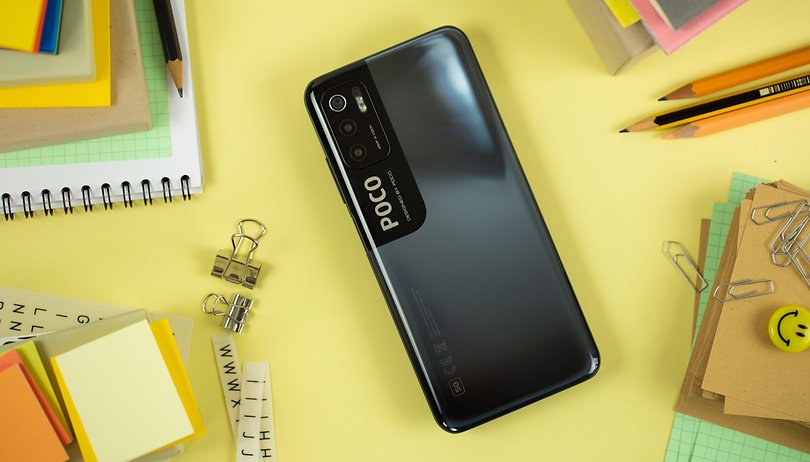

Just a few months ago after releasing a very capable Poco M3 handset, Xiaomi has now taken things one step further with the Poco M3 Pro 5G that carries a price tag of $199. At this price point, it is placed in direct competition with the Realme 8 5G as well as the Redmi Note 10 5G, considering how both smartphones have almost the same technical specifications.
Good
- Smooth 90 Hz LCD screen
- Solid 5,000 mAh battery life
- MediaTek Dimensity 700 performance impresses
- Bold design
- 3.5mm jack
Bad
- Lack of AMOLED display and 120 Hz refresh rate
- Camera module lacks an ultra wide-angle lens
- 18W fast charge is not fast enough
- Basically a rebranded Redmi Note 10 5G
- Lack of IP certification

Poco M3 Pro 5G in a nutshell
Upon stumbling upon the Poco M3 Pro, I lamented just like Jeff Goldblum did in Jurassic Park, that Xiaomi was so obsessed with being able to launch yet another cheap 5G smartphone, so much so that the manufacturer never questioned whether it really should have done so.
Retailing for $199 a pop, the Poco M3 Pro 5G packs the same mid-range MediaTek Dimensity 700 SoC as the Redmi Note 10 5G. Here, you will also find the very same 6.5-inch Full HD+ LCD display with a 90 Hz refresh rate. The 48+2+2 MP triple camera module is also the same, and the 5,000 mAh battery that fast charges at 18W fast charge is, well, you get the idea.
Rest assured, I am no greenhorn having just realized this year that Chinese smartphones tend to roll out rebadged models from a particular brand and its "sub-brands". I'll never place blame on the manufacturer for offering too many affordable smartphones on the market, either. The more variety there is to choose from (more choices doesn't necessarily mean a greater number of variants), the better it is for the competition.
But that's exactly the problem with the Poco M3 Pro 5G. It's not an addition to Xiaomi's catalog, but rather, a mere filler that recycles an old idea. Despite its hardware specifications and value for money proposition, the Poco M3 5G was anything but necessary. Xiaomi has managed to achieve the impossible mathematical feat of 1+1=11. Yes, after Goldblum, I quoted Van Damme.
Design: A "young and dynamic" look
What I found to be most innovative, or at least the only difference that it does not share with its Redmi twin, is the design - especially when it comes to the camera module at the back.
What I liked:
- Camera module design.
- Matte coating that provides a better grip.
- 3.5 mm jack.
- 90 Hz refresh rate of the display.
What I did not like:
- The display is not bright enough.
- Slightly bulky dimensions and weight.
- Lack of IP certification.
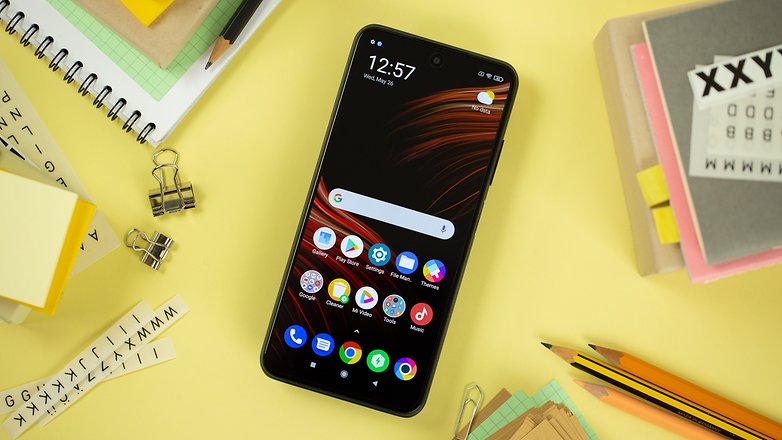
I would have much preferred the yellow color, but my review unit from Xiaomi arrived in a shade of Power Black. This is definitely far less flashy and cool. It is a shame because the combination of yellow with the black outline on the camera module at the back looked really good in the official product photos.
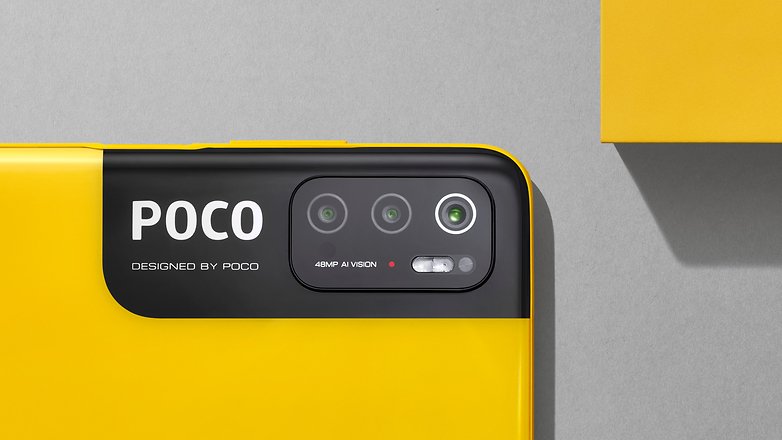
As for the rest of the design, we find the classic form factor of a mid-range smartphone - that is, slightly larger dimensions (161.8 x 75.34 x 8.92 mm) that is a tad heavy at 190 grams. Again, these are the same measurements as the Redmi Note 10 5G. However, the matte coating on the smartphone's chassis does provide a more confident and comfortable grip.
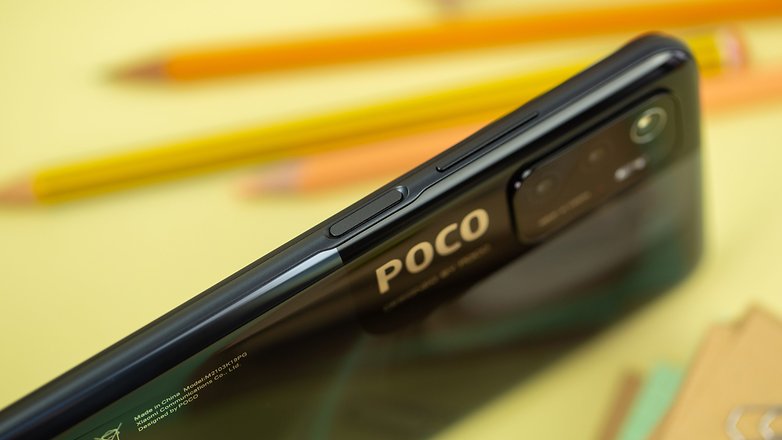
In front, the 6.5-inch LCD display is really nothing special. It's a well-calibrated panel whose with an adaptive 90 Hz refresh rate that is smooth enough when you use it for your apps and games (apart from messaging or video/music streaming apps which are locked in at 60 Hz).
The smartphone retains a rather noticeable chin and I found the volume buttons to be placed a wee bit too high for my liking. The fingerprint reader at the right edge, however, proved to be very responsive. The presence of a 3.5 mm jack is also a good thing for those who still have their wired headphones.
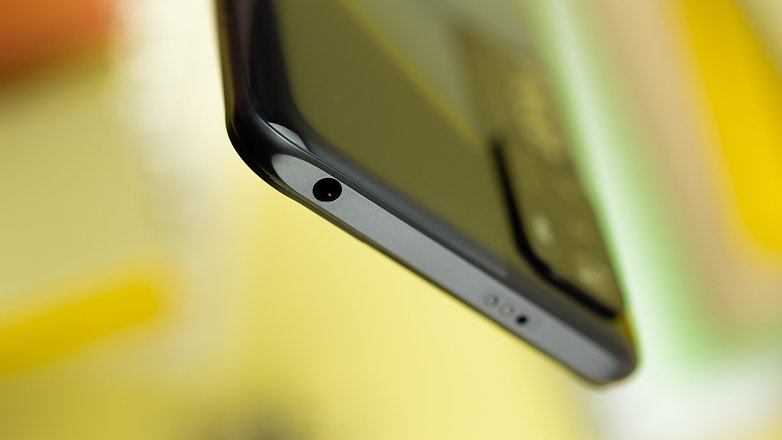
Overall, the design of the Poco M3 5G is perhaps the most interesting thing about this handset. I really like the younger, edgier, and slightly more extravagant look of the Poco compared to its Redmi counterpart.
Interface: MIUI 12 done Poco-style
The Poco M3 Pro 5G ships with MIUI 12 right out of the box, an Android 11 skin that we are all familiar with. But there are some details that worth mentioning despite not diving into a UI review.
What I liked:
- MIUI is highly customizable.
- Additional data protection features.
What I didn't like:
- Presence of bloatware.
- Ads in the user interface.
- Photo app is messy.
- Lack of floating windows.
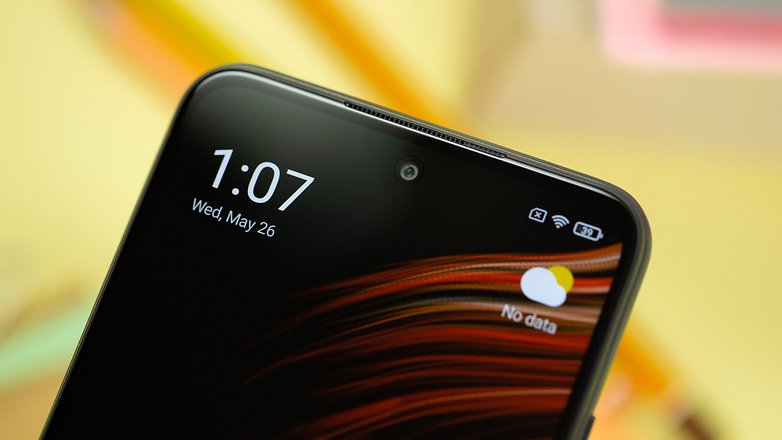
Visually, the MIUI 12 skin that Poco uses changed only slightly without making any compromises. Here, you will find yourself in familiar territory with the same interface, which is a little (or a lot, according to some) bloated but highly customizable.
I was pleasantly surprised by the addition of the ability to remove metadata and geolocation information whenever you share a file. You can even prevent the smartphone from taking note of such data right at the source, such as when you snap a photo.
But that's the only positive thing I have to say about the photo app. I found it to be very poorly laid out and incomplete. First of all, there is no shortcut to zoom in or out. Secondly, the macro mode remains hidden in the camera settings, where you will need to dig around in order to access it. Not that the macro camera is worth mentioning, but that's another can of worms altogether.
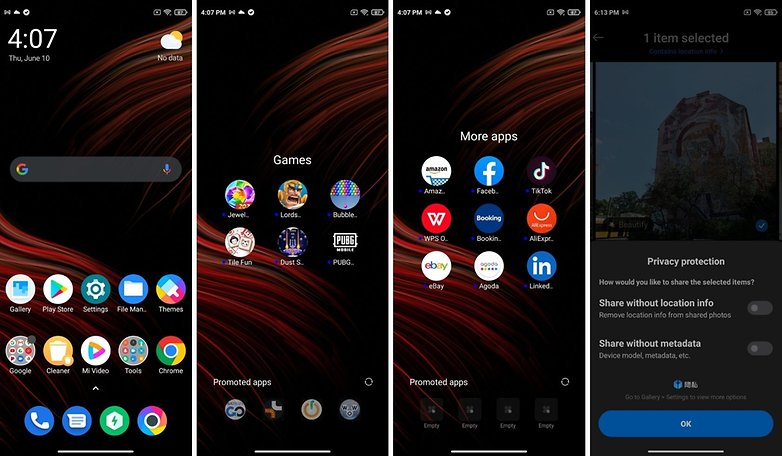
Xiaomi obliged as usual with their standard range of bloatware that accounts for approximately fifteen third-party applications (Linkedin, Booking, AliExpress, eBay, TikTok, Amazon, etc) and nearly 6 games (all of which come with micro-transactions, it goes without saying). I'm well aware that almost all manufacturers do this and Google also forces its own apps into each skin as well. However, it proved to be overwhelming on the Poco M3 Pro.
Add all of the above to the native Xiaomi apps thrown into the mix, and you end up with an overcrowded home screen upon booting it up for the very first time. This is one of my pet peeves! Last but not least, the Poco M3 Pro can be used in split screen mode, but doesn't offer the option to cater for floating windows, something which I believe is present on the Redmi Note 10 5G.
Finally, let's talk about updates. At the time of publishing this review, I am still on the April 2021 security patch. The smartphone was released on May 20, 2021. Based on Xiaomi's unofficial update policy, we can expect 1 new major Android version and up to 3 MIUI updates for a Poco that is part of the M range. Nothing impressive about that at all!
Overall, the MIUI 12 interface is still nice to use, although it is not the easiest skin to dive right in. I do, however, lament the lack of usability in the photo app on the Poco M3 Pro. The update policy is also nothing to shout about, but that is not a determining factor for a device in this price range. And the Mi-fan(boys) will once again argue that Android updates are useless anyway, since MIUI is so far ahead of the game...
Performance: The MediaTek Dimensity 700 5G is not very fast
The Poco M3 Pro is powered by the mid-range MediaTek Dimensity 700 5G SoC while its little sibling, the Poco M3, packs a Qualcomm Snapdragon 662 chipset.
What I liked:
- No overheating issues.
- Decent gaming performance.
What I didn't like:
- This ROM prevented me from running any benchmarks!
Unfortunately, Xiaomi made sure to disable all attempts at running benchmarks on the review unit that they sent. I've looked left and right, hunted up and down, and it seems I'm not the only reviewer affected by this (our colleagues at GSMArena also experienced the same problem).
This is a somewhat common practice among manufacturers, but it normally only happens on a temporary software build because the smartphone is still under embargo and has not yet been officially released. I find it incomprehensible that the block is still active 2 months after the smartphone's release.
So, as far as benchmarks are concerned, I can only refer to the scores achieved by the Realme 8 5G, which runs on the same SoC as well as a 90 Hz LCD display. I will update my review when I can run benchmarks properly on this smartphone.
Realme 8 5G - Benchmarks
| Model/Test | Geekbench 5 CPU (Single / Multi) | Slingshot 3D Mark | 3D Mark Wildlife | Stress test 3D Mark Wildlife |
|---|---|---|---|---|
| Realme 8 5G | 573 / 1769 | 3.321 | 1.100 | 1.109 / 1.090 |
| Realme 7 5G | 581 / 1801 | 4.271 | 1.585 | 1.594 / 1.583 |
| Realme 8 Pro | 568 / 1.685 | 3.671 | 1.050 | 1.050 / 1.045 |
In my daily use, I am happy to report that I did not encounter any overheating issues, even during extended gaming sessions (approximately an hour). I was able to run Call of Duty Mobile with the high graphics settings at 30 FPS without suffering from noticeable frame rate loss.
Overall, I felt like the GPU was a bit underpowered. However, the SoC in general offered a rather decent performance that is worthy of what you would expect in this price range.
Camera performance: Where's the ultra wide-angle?
The Poco M3 Pro packs a triple camera module that misses out on a telephoto lens, in addition to being deprived of an ultra wide-angle lens. Instead, Xiaomi preferred to keep its main 48 MP sensor company with two totally useless macro and depth sensors.
What I liked:
- Rich detail captured during the daytime with the main lens.
- Surprisingly good-looking selfies.
What I didn't like:
- Aggressive software processing even in daylight.
- Camera module is too limited without an ultra wide-angle lens.
- Digital zoom performance is average.
- Macro photos are not captured accurately.
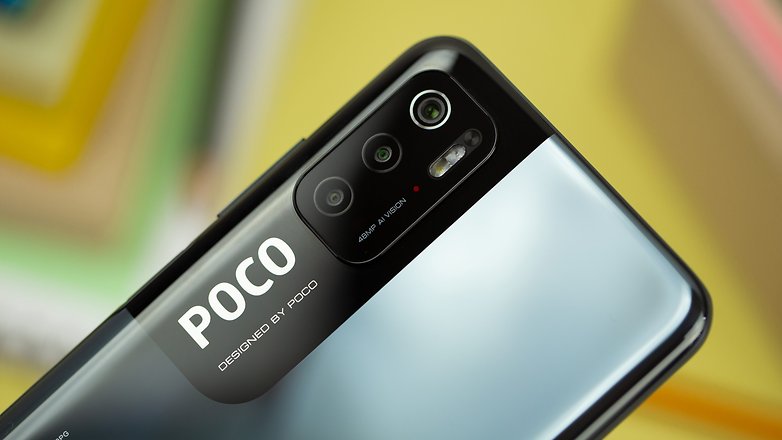
The main lens of the Poco M3 Pro 5G performs well during the day when everything around you is bright. The camera module is really one of the most basic that you can find on a smartphone today, so you should obviously not expect to be blown away by the results.
The level of detail is very good in wide-angle. Colors are reproduced in a natural manner, provided that the AI mode is deactivated. I have reviewed very few smartphones that fall under the $200 price point this year, but I find that we are comfortably in the top range in terms of rendering, especially for a module that is so limited.

On the other hand, we have immediate concerns about the dynamic range performance. Shadows tend to drown out the scene. In somewhat complex scenes, the smartphone had trouble handling the darkest areas, preferring instead to darken the entire scene just to be safe.

As for the rest, I could notice a certain smoothing effect, like a veil that flattens textures and other rough edges, giving the impression of looking at an oil painting on canvas. This is particularly visible when it involves both foliage and vegetation.

As for the zoom performance, I honestly expected worse although the absence of a telephoto lens is almost par for the course for a device in this price range. Even some flagship cameras don't carry one. But if digital zoom inevitably leads to a loss of quality, you can still make out some roughness and sharpness at 2x magnification. On the other hand, everything beyond this zoom level (10x is the maximum on the Poco M3 Pro) is hardly usable.



As for the macro mode, it remains tucked away in the settings of the photo app. It's as if Xiaomi knows that its macro lens is completely useless. The 5cm focus distance allows for some pretty cool shots, but only if you managed to take a picture without shaking your hand too much. Any form of stabilization is completely absent, and the focus is really terrible! I found that the rendering lacks overall detail with this macro sensor to be really useful.

When it comes to selfies, the Poco M3 Pro carries an 8 MP selfie lens. Right now, I really appreciate this tiny sensor. Rendering proved to be excellent, and if I were given a blind test with selfies taken with the Poco M3 Pro and some of the flagships I reviewed, I would have had a hard time telling the difference.
The level of detail captured is very good, with effective exposure management to ensure that all the right colors are in place. This is a pleasant surprise, to say the least. Obviously, such observations apply only to shots captured during the day and under good lighting conditions. As soon as you head indoors or are in a low light scene, the smoothing ruins everything.

Finally, when it comes to night shots, the pictures are pretty bad but it's understandable for smartphones in this price range. I think I have gotten too used to reviewing high-end smartphones that nothing less than that cuts the mustard for me anymore. However, I found digital noise to be too present despite very aggressive smoothing. Scenes remain well lit, but they are not that great looking.
Overall, I found the camera experience to be a decent yet unexciting one. I really think that this is specific to smartphones in this price range which cost less than $200, where you obviously can't expect a great performing camera phone. But seriously, I had the impression that this handset carried only one camera than three, which makes the possibilities of taking pictures too limited.
Battery life: The 5,000 mAh battery that can just handle anything
The Poco M3 Pro 5G has a large 5,000mAh battery that touts wired fast-charging of 18W. Each purchase will include a 22.5W charger, which is similar to you-know-what.
What I liked:
- Solid battery life.
- Charger is included.
What I didn't like:
- Battery utility too limited.
- Extremely slow charging time when the smartphone is turned off.
The 5,000mAh battery remains average for a smartphone in this price range. Under intense use that includes an outdoor photo session of two and a half hours, accompanied by plenty of music streaming and an hour of non-stop gaming, the smartphone still had more than 40% of battery left.
Based on a more 'normal' usage pattern as a daily driver with the refresh rate locked at 90 Hz, I was easily able to achieve 16 hours of use before seeing the battery life fall below the 20% mark.
With an average screen on time of 6 hours per day, it is therefore quite possible to have it last for more than two days of use (not two whole days as we must take into account the standby time when the smartphone is not active).
Given the battery capacity, the fast charge here is not the fastest on the market. In 30 minutes, I never recovered more than 33% of battery life. While that is enough for a day's use, but it's still not very efficient. When charging from 0 to 100%, it will take approximately 2 hours to do so, with my personal best standing at precisely 1 hour and 58 minutes
Overall, the Poco M3 Pro 5G offers excellent battery life, sitting pretty at the top for its price range. The wired charging could have been faster though.
The technical data sheet
Poco M3 Pro 5G
| Specs | Poco M3 Pro 5G |
|---|---|
| Processor | MediaTek Dimensity 700 |
| Memory |
|
| Expandable storage | Yes |
| Screen |
|
| Photo module |
|
| Video | 1080p at 30 FPS |
| Battery |
|
| OS | MIUI 12 based on Android 11 |
| Audio | 3.5mm jack |
| Connectivity | Wi-Fi 2.4/5 GHz / Bluetooth 5.1 / NFC / LTE / 5G / Dual SIM |
| IP certification | None |
| Dimensions & Weight |
|
| Colors | Power Black, Poco Yellow, Cool Blue |
| Price | $199 / $229 |
Conclusion
Okay, I've been hammering this fact throughout this review, that the Poco M3 Pro 5G has two big competitors: the Realme 8 5G and the Redmi Note 10 5G.
The Redmi Note 10 5G offers exactly the same hardware specifications but is currently priced $30 more expensive on Xiaomi's official store, which stands at $229 compared to $199 for the Poco M3 Pro. The only distinguishing differences between the two models are the design and launcher. I would therefore advise you to opt for the Poco M3 Pro 5G in this case.
The Realme 8 Pro 5G also has similar hardware specifications with a 90 Hz LCD display, a Dimensity 700 SoC, a trio of 48+2+2 MP sensors, a 5,000 mAh battery with an 18 W charger. Above all, it retails for $199. One difference would be the base configuration between these two handsets, with the Realme 8 5G sporting 6 GB of RAM while the Poco M3 Pro is mated to 4 GB of RAM.
In order to have 6 GB of RAM on the Poco M3 Pro, you will have to fork out $229. In that case, I would recommend the Realme 8 Pro 5G. Personally, if I had to spend between $199 and $229 on either a Xiaomi or Poco device, I would opt for the Poco X3 Pro that we unfortunately could not review.
At $229, it delivers hardware specifications that are close to an entry-level flagship that is powered by a Snapdragon 860 SoC, a 120 Hz LCD display, a similar camera module but with an extra 8 MP ultra wide-angle lens, a larger 5,160 mAh battery, and faster wired charging at 33 W.
That's why I'm only giving the Poco M3 Pro 5G a 2.5/5 rating. It's a good mid-range smartphone with very good value for money for less than $200. However, it has no reason to exist apart from misleading consumers by adding on to an already confusing Xiaomi catalog.














